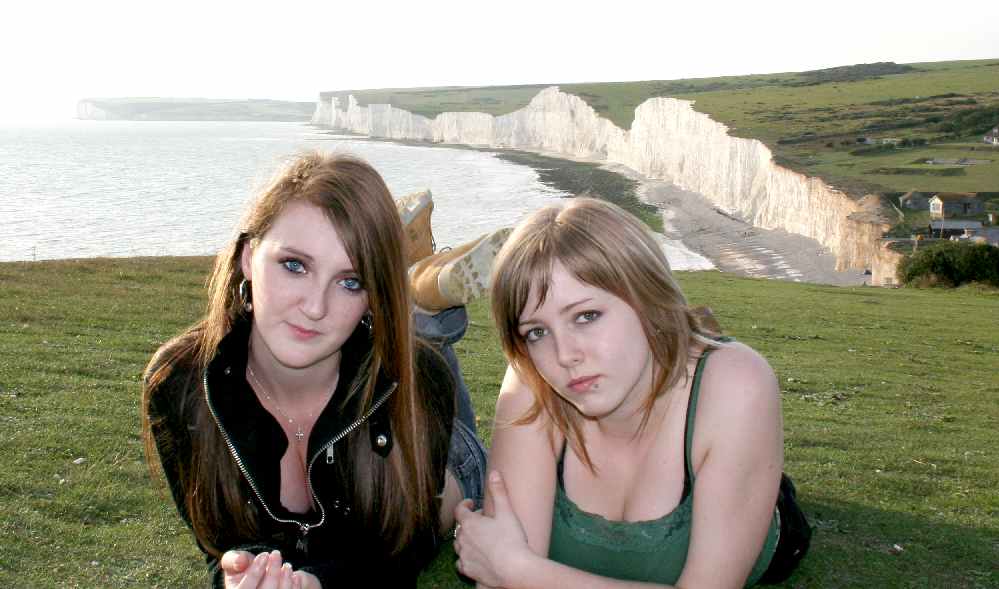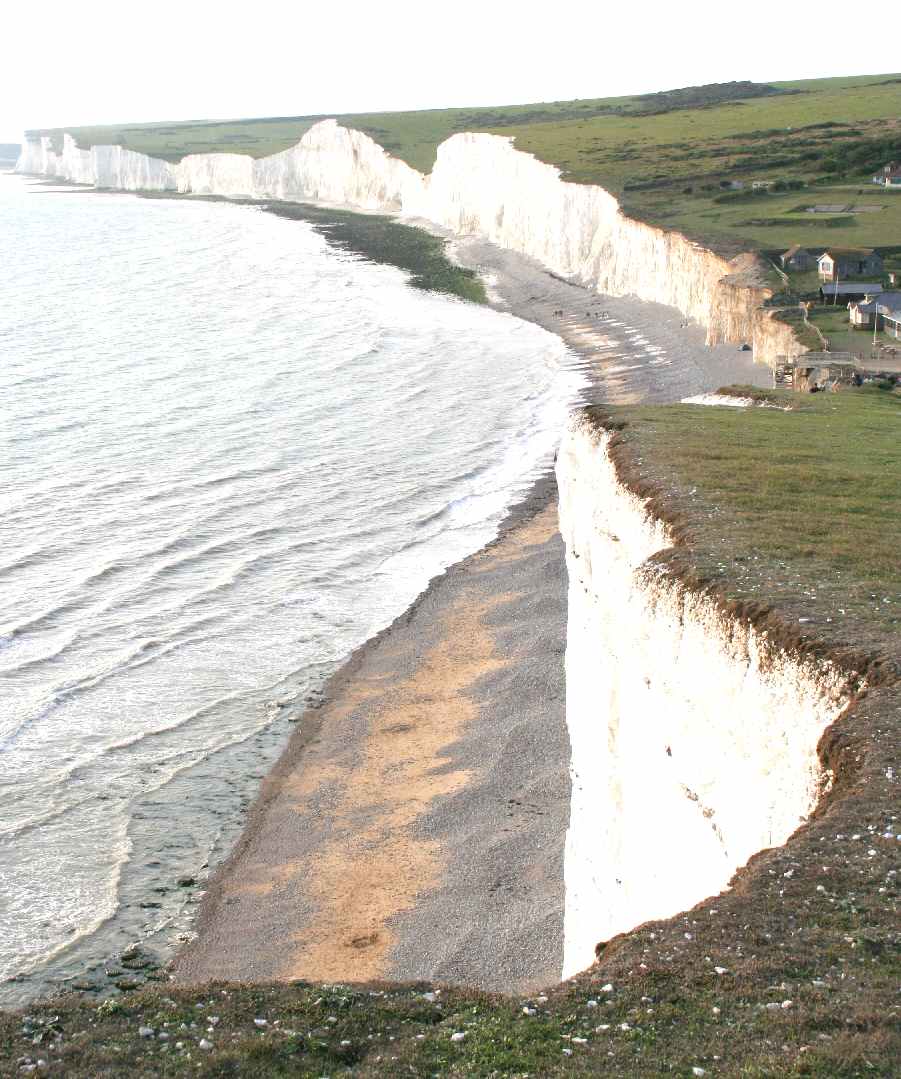|
BIRLING GAP
Please use our A to Z INDEX to navigate this site
|
|||||
|
Sussex is a glorious county, the so-called garden of England and for very good reason. I've lived in Sussex most of my life, including: Brighton, Eastbourne, Seaford, Newhaven, Hadlow Down, and of course Herstmonceux.
There is so much of interest to see and do in the United Kingdom, and we hope to expand the local geography section as time allows, to cover the most interesting aspects of this wonderful country.
Birling Gap is a coastal hamlet in East Sussex on the South Downs between Eastbourne and Seaford It is situated on the Seven Sisters not far from Beachy Head and is owned by the National Trust.
Birling Gap is a beautiful and tranquil enclosed pebble beach set below the dramatic backdrop of the Seven Sisters cliffs. Accessible from the pretty Sussex village of East Dean, the short drive to the beach offers wide views of the rolling Sussex downland. There is plentiful parking, and after descending the
wooden staircases to explore the beach or taking a dramatic walk along the clifftops, refreshments are available from the bar or coffee shop attached to the Birling Gap Hotel.
The Sunshine Girls (Hana and Chrissy) on the 7th of the famous Seven Sisters
HISTORY
1878; The Admiralty builds eight Coastguard cottages at Birling Gap using a revolutionary new material called 'no fines' concrete.
1898; A small hotel is opened at Birling Gap. Seven other residential properties were built in the early
1920's
1951; The cottages pass into private ownership but coastguards continue to man a station, sometimes risking their lives in sea and cliff-top rescues.
1973; The first cliff-edge cottage is demolished by Hailsham Council. At this point no-one was trying to save the cottages.
1983; The National Trust purchases Birling Gap for an undisclosed sum. This includes the Hotel, four of the remaining cottages, the car park and some downland.
1992; At the urging of the Ministry of Agriculture, Food and Fisheries, Wealden District Council commission an engineering study by marine engineers, Posford Duvivier, to investigate how to defend the hamlet of Birling Gap.
1993; Posford Duvivier recommend a rock 'revetment' at the base of the cliff as feasible, realistic and affordable.
1993; Wealden Council DECLINES to implement the report by Posford Duvivier !
1995; The second cottage is demolished by its owner, The National Trust, who evict the tenant just before Christmas! The adjoining cottage is damaged in the process.
1996; A new report with a detailed cost/benefit analysis shows that it would be economically advantageous to build a rock revetment.
1996; Birling Gap Cliff Protection Association formed.
1998; Environmental study reports revetment would cause minimal damage to the area. Legal opinion establishes National Trusts responsibility to safeguard its neighbour's properties.
1999; nearly 50,000 signatures gathered to date from the public in support of a rock revetment scheme.
Interesting features
Coastal erosion has already removed the hotel and some of the row of fishing cottages built in 1878. Today there is a café/tea room, and steps leading down to the beach and the Seven Sisters chalk cliffs.
The beach, which was awarded the Blue flag rural beach award in 2005, is advertised by Naturist UK.
General
Access & Parking
Description
"very clean" and "in a beautiful setting, the white chalk cliffs of the seven sisters behind you afford great views down the coast"
Safety and ease of swimming depends upon the state of the tide, owing to rocks which make entering and leaving the water difficult. Around high tide (when the rocks are well below the surface) or at low tide when the rocks are visible are the safest times:
"there is a shallow platform of sharp rocks... the waves push you back onto them (I've got the cuts to prove it!)"
Even at the height of the season the naturist section of Birling Gap is relatively quiet, with a mixture of couples and singles, the predominant age group being 40-50's.
"Another positive is that the beach allows you 30-45min walk up the coast over the pebbles to the headland, where a new bay begins.. I only passed three clothed couples beach walking, and to avoid confronting them, I sat down behind a boulder and waited until they passed... I would definitely recommend Birling Gap..."
Birling Gap made the news recently because local residents are campaigning for work to be undertaken to protect their properties from the on-going coastal erosion, while the National Trust feel that nature should be left to take its course.
Facilities - There is a cafe and toilets are available in Birling Gap.
Water Quality - Reported to be good.
Birling Gap is disappearing into the sea as the chalk cliffs crumble
PRESS RELEASE FROM ENGLISH NATURE: RE PLANNING APPLICATION TO SAVE COASTLINE
Birling Gap - special coastline protected ...
English
Nature welcomes the Secretary of State for the
Environment, Transport and the Regions' decision not to
allow coastal defences at Birling Gap. This follows an
eight day Public Inquiry held last July. English Nature
and the National Trust had opposed a proposal, put
forward by the Birling Gap Cliff Protection Association,
to construct a rock wall at the base of the cliffs at
Birling on the Sussex coast. Senior
Conservation Officer Bob Edgar, who gave evidence for
English Nature at the Inquiry, said: "Allowing
areas like Birling Gap to erode and maintain beaches is
essential to help the coast protect us naturally from
sea level rise. The cliffs at Birling Gap are not only a
beautiful part of the local landscape but are also
nationally important for the study and understanding of
the Ice Ages. They provide the best example of a
cross-section through a dry valley anywhere in Britain.
Sites like Birling enable us to learn about past changes
to our climate and to increase our understanding about
how climate change may affect us in the future." This
decision safeguards an extremely valuable part of
England's natural heritage including the nationally
important geological interest of the Beachy Head to
Seaford Site of Special Scientific Interest. English Nature is also pleased that the National Trust have reaffirmed their commitment to helping neighbouring cottage owners at Birling in the light of the decision.
Notes for editors
Birling Gap is four kilometres west of Beachy Head, near Eastbourne, East Sussex. This part of the coastline is of national geological interest. A row of cottages on the cliff edge, some owned by the National Trust and some privately owned, is being undermined by erosion of the soft chalk cliff by the sea. A local group, the Birling Gap Cliff Protection Association, proposed to put a rock revetment at the base of the cliff as a protective measure. However, this plan was opposed by both English Nature and the National Trust on the grounds that it was environmentally damaging, as well as impractical. A Public Inquiry was held in July 2000 at Alfriston, East Sussex.
The decision by the Secretary of State for the Environment, Transport and the Regions was announced on 5 March 2001. He accepted the recommendation by the Planning Inspector that planning permission for the rock revetment should be refused. He accepted that the defences would harm both the biological and geological interests of the site. He also accepted that they would be visually harmful and therefore in conflict with the area's status as an Area of Outstanding Natural Beauty (AONB).
The National Trust have renewed their previous offer to acquire the three private cottages (two of which are unoccupied) and bear the costs of their demolition when the time comes. They have also offered to make available to the one remaining owner-occupier, a cottage in the same row of houses which has a projected life of more than 30 years. This is significantly longer than the time which would have been "bought" for the cottages had the rock revetment been allowed and had it succeeded in keeping the sea at bay.
English Nature continues to place a high priority on building effective partnerships with land owners and managers over the conservation of SSSIs. Positive relationships built upon personal contacts, sound advice and positive incentives will deliver most for wildlife and natural features and we will continue to favour partnership rather than regulation to achieve favourable condition.
BIRLING GAP HOTEL
Welcome to the Birling Gap Hotel, the most friendly family run hotel on the South coast of England. Situated on top of the magnificent Seven Sisters Cliffs. Birling Gap is a small hamlet close to Beachy Head and just 4 miles west of Eastbourne. Visitors can enjoy wonderful walks over the nearby Downland. There are also many local old castles and houses worth exploring. The hotel offers some of the most beautiful sites to be seen with rolling downland all around and just 1 mile south of the pretty village of East Dean on the main south coast road (A259), it makes this the ideal location to spend a holiday, weekend break or just a day trip. The beach is situated at the base of the chalk cliffs, it has many rock pools and is a marine nature reserve.
Information and General Enquiries
not hesitate to contact us on +44 (0)1323 423197 or send an email to:
reception@birlinggaphotel.co.uk http://www.birlinggaphotel.co.uk/
dates you would like to arrive and depart, number of bedrooms (stating whether single, double or twin) etc.
CAMPAIGN TO SAVE BIRLING GAP
LINKS:
SUSSEX INDEX A - Z
ARUNDEL CASTLE - WETLANDS WILDFOWL TRUST BEACHY HEAD - BELL TOOT (BELLE TOUT) LIGHTHOUSE BISHOPSTONE CHIDDINGLY - HORSE SHOW and GYMKHANA CUCKMERE VALLEY - EXCEAT EAST
SUSSEX HADLOW DOWN HERSTMONCEUX - CASTLE - CE SCHOOL - LINKS - FESTIVAL - MUSEUM LIME PARK - HERSTMONCEUX - AUGUSTUS HARE SHOREHAM - PORT SUSSEX - SUSSEX BAY, MARINE REWILDING PROJECT TWISSELLS MILL, OLD HEATHFIELD WEALDEN DISTRICT COUNCIL - COUNCILLORS 2023
Solar Cola drinkers care about planet earth
.. Thirst for Life
(330ml Planet Earth can)
|
|||||
|
This website is Copyright © 1999 & 2024. The bird logo and name Solar Navigator and Solar Cola are trademarks. All rights reserved. All other trademarks are hereby acknowledged. Max Energy Limited is an environmental educational charity.
|


